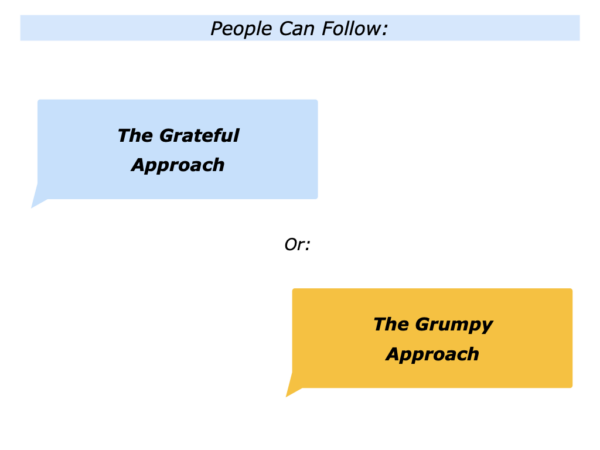
There are many ways to live life. Some people choose to follow the grateful approach rather than the grumpy approach. The route they take has consequences for both themselves and other people.
Different people follow the grateful approach in different ways. Some focus on the themes of gratitude, generosity and doing good work that helps people or the planet. Let’s explore how they may translate these into action.
Gratitude
People who are grateful often count their blessings rather than their burdens. Bearing this in mind, they often want to be generous and give to other people.
The starting point is feeling grateful for what they have been given in life. They then want to express this feeling and help others during their time on the planet.
Grateful people appreciate their assets. They focus on what they do have rather than worry about what they don’t have. Such people often follow the approach described by Brother David Steindl-Rast.
Gratefulness is the key to a happy life that we hold in our hands, because if we are not grateful, then no matter how much we have we will not be happy – because we will always want to have something else or something more.
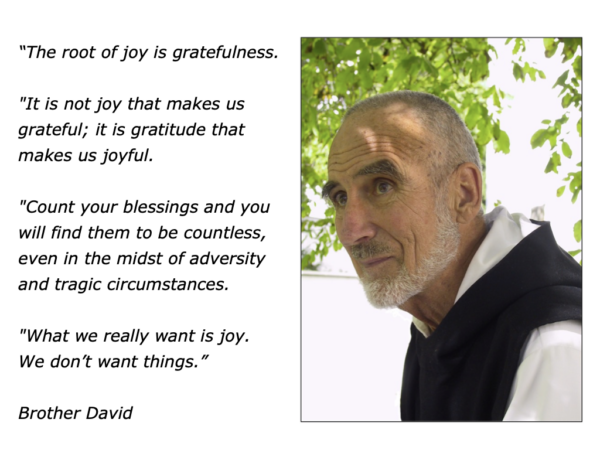
There is a joy in gratitude, says Brother David. The more grateful we are, the more reasons we see to be grateful and this develops our inner strength. We get more ability to give to others and this can become a virtuous circle. We sow seeds that can spread joy in the world.
Many people develop their sense of gratitude as they get older. This often involves giving to others as well as enjoying the moment. Laura Carstensen, an expert on longevity, explains the reasons for this in her book A Long Bright Future.
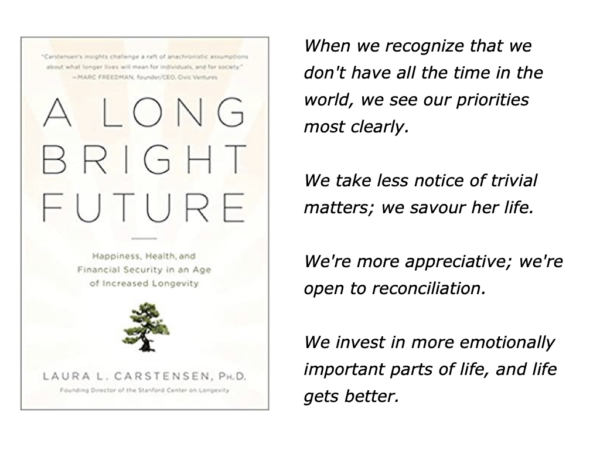
Laura has given many interviews about the characteristics demonstrated by people as they get older. The following section includes some of her quotes on this theme.
The paradox of aging is that recognising that we won’t live forever changes our perspective on life in positive ways. When people recognize the fragility of life and they don’t have all the time in the world. People see what’s good about life.
Older people count their blessings because they’ve had enough life experience to recognize them. They direct their cognitive resources, like attention and memory, to positive information more than negative.
Mentally sharp older adults show this positivity the most. Under conditions where it really matters, older people process negative information just as well as the positive information.
Increasing positivity with age can be explained by the idea that people’s time horizons grow shorter as they approach their later years. Young adults in their 20s tend to see their futures as limitless, whereas older adults perceive more constraints on time.
This shortened sense of time makes people focus on goals that can be realized in the here and now. These tend to be about emotion, or what feels good, rather than engaging in activities that may pay off much later.
Now it’s really too simplistic to say that older people are “happy.” In our study, they are more positive. But they’re also more likely than younger people to experience mixed emotions – sadness at the same time you experience happiness; you know, that tear in the eye when you’re smiling at a friend.
And other research has shown that older people seem to engage with sadness more comfortably. They’re more accepting of sadness than younger people are.
We suspect that this may help to explain why older people are better than younger people at solving hotly charged emotional conflicts and debates. Older people can view injustice with compassion, but not despair.
As we age, our time horizons grow shorter and our goals change. When we recognize that we don’t have all the time in the world, we see our priorities most clearly. We invest in more emotionally important parts of life, and life gets better, so we’re happier day-to-day.
Let’s return to your own life and work. What are the things you are grateful for being given or having in your life? Here are some of the things that people mention when exploring this theme.
I am grateful for:
Having encouraging parents … Having been given certain strengths … Having experiences that taught me how to deal with setbacks … Having the chance to do stimulating work … Having a wonderful partner … Having been granted more time to live after a challenging illness.
If you wish, try tackling the exercise on this theme. This invites you to complete the following sentence.
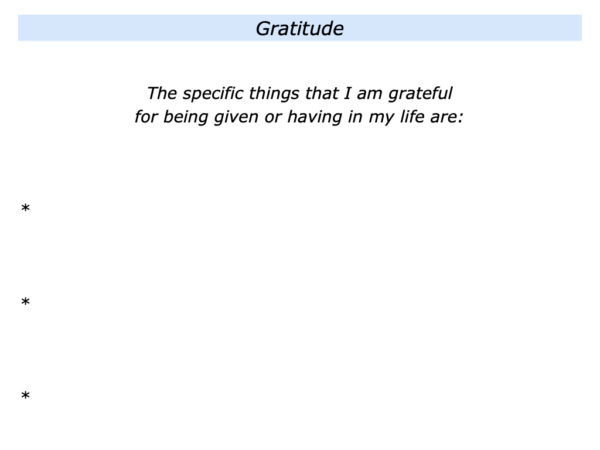
Generosity
Generous people are often grateful for what they have been given. They remember the love, encouragement and chances they have been given by other people.
Experiencing a sense of gratitude, they want to pass on similar experiences to other people. Such people like to give to others but they are not gullible. They err on the side of giving people opportunities but they do not choose to become victims.
Generous people often believe in the circle of life. They believe that being kind to others, for example, can increase the chances of kindness being spread around the world.
One approach is to be a giver rather than a taker. Adam Grant described how some people take this approach in his book Give and Take. Below is an excerpt from the Brain Pickings website that provided a summary of the book.
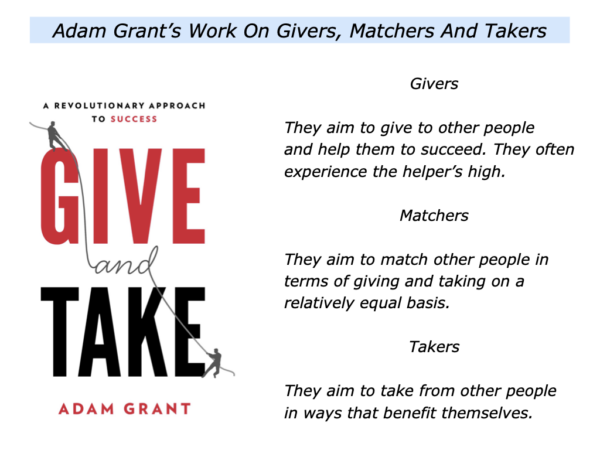
Givers prefer to give more than they get. Takers tend to be self-focused, evaluating what other people can offer them. Givers are other-focused and pay attention to what other people need from them.
If you’re a giver at work, you simply strive to be generous in sharing your time, energy, knowledge, skills, ideas, and connections with other people who can benefit from them.
In the workplace, however, few of us are purely givers or takers – rather, what dominates is a third style. We become matchers, striving to preserve an equal balance of giving and getting.
Matchers operate on the principle of fairness: when they help others, they protect themselves by seeking reciprocity. If you’re a matcher, you believe in tit for tat, and your relationships are governed by even exchanges of favours.
Giving, taking and matching are three fundamental styles of social interaction, but the lines between them aren’t hard and fast. You might find that you shift from one reciprocity style to another as you travel across different work roles and relationships.
Givers, takers and matchers all can – and do – achieve success. But there’s something distinctive that happens when givers succeed: it spreads and cascades.
Givers succeed in a way that creates a ripple effect, enhancing the success of people around them.
The main reason for being a giver is to help other people but there may be other by-products. People often feel good after helping others.
They can experience a rush, followed by a sense of calm. It is as if they have served something much greater than themselves. Sometimes they experience what is called the helper’s high.
Some people get their highs by helping people in their daily lives. The positive majority of people take this route. They love to encourage other people when acting as parents, educators, coaches, leaders, trusted advisors or playing other roles.
Some individuals help others directly – such as when working as a nurse, teacher, hospitality worker or in the caring professions. Some may do so more indirectly – such as when working as a software developer, scientist, researcher, architect or another profession.
Let’s return to your own life and work. Imagine that you want to continue to be generous and give to people. How can you do this in your own way? What may be the benefits of taking this approach – both for yourself and other people?
If you wish, try tackling the exercise on this theme. This invites you to complete the following sentences.
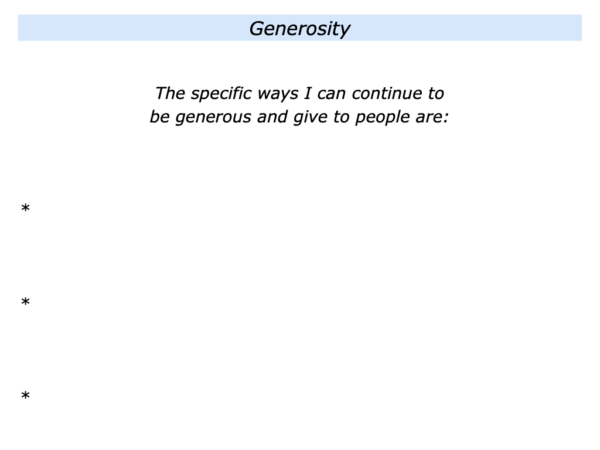
Good Work
People who want to give to others often want to do good work. There are many definitions for doing such work. The one we are using here is doing good work that helps people or the planet.
Different people follow this approach in different ways. Some aim to build on their strengths, follow strategies that work and help people to achieve success.
The following section looks at how some people have aimed to do good work during their time on the planet. They have tried to give practical hope to both present and future generations.
Inge Genefke – Caring
For The Victims Of Torture
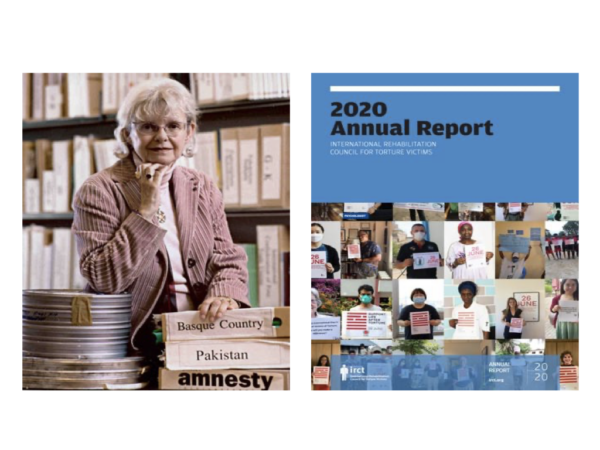
Some people try to crush the human spirit. Others try to maintain or revive it. Inge Genefke, a Danish doctor, founded the International Rehabilitation Council for Torture Victims in 1985. It aimed to do three things.
To rehabilitate people who have been tortured and to care for their families;
To educate people in the treatment of torture victims;
To contribute to the prevention of torture.
Since then the IRCT has grown and has groups all over the world. Here is the present mission that you can find on its web site.
The IRCT is a health-based umbrella organisation that supports the rehabilitation of torture victims and the prevention of torture worldwide.
Our members comprise more than 140 independent organisations in over 70 countries. Our work is governed by these member organisations.
Today, we are the largest membership-based civil society organisation to work in the field of torture rehabilitation and
Here is some background on Inge and the work of the IRCT. You can find this on the web site and is based on Thomas Larsen’s book: The Meeting with Evil – Inge Genefke’s Fight Against Torture.
Dr Genefke became aware of the existence of torture while still a child during Germany’s occupation of Denmark in World War II.
With a father who was active in the Danish resistance movement there was a very real risk that torture would have a direct impact on her life.
Fortunately, that risk never materialised. But it had set a young girl on the path of remarkable journey.
In 1974, after training as a neurologist, Dr Genefke, together with three fellow doctors, responded to a call by Amnesty International (AI) to help diagnose torture victims and produce forensic evidence that could help hold torturers to account in a court of law.
Forming AI’s first medical group focusing on the question of torture, the doctors began to see torture survivors who had fled the cruel regimes then in place in Latin America, notably Chile, Argentina and Uruguay, as well as in Greece.
“After examining just the first 15 victims, we concluded they suffered horrible psychological sequelae. Of course we found physical sequelae.
“But the worst sequelae were psychological: depression and anxiety, the inability to concentrate and the terrible guilt”, says Dr Genefke, who has personally provided direct treatment to hundreds of torture survivors.
In 1982 she founded one of the world’s first clinics specialised in torture rehabilitation, the Rehabilitation Centre for Torture Victims (now the Rehabilitation and Research Centre for Torture Victims).
Three years later, she founded the International Rehabilitation Council for Torture Victims (IRCT).
Ever since she has worked incessantly and with fierce energy to garner support for the fight against torture, countless times addressing politicians and loudly criticising those in power in a wide-range of countries- democracies as well as dictatorships.
Commenting on the so-called “War on Terror” she has time and again refuted the notion that torture can be a safeguard against terrorism:
“Torture is not about extracting vital information to make the world a safer place, but rather to break the spirit of dissidents.
“It does not prevent terror; it creates terrorists. When you torture, you create violent hatred.
“If my father had been tortured by the Germans during their occupation I’m sure I would have become violent” says Dr Genefke.
The key to her remarkable achievements and dedication lies in her insistence that indifference and ignorance are the greatest foes of a world without torture:
“Often I am asked how I can stand being involved in this field. I also find it painful hearing about torture, but rather that than be left in ignorance.
With knowledge, I can fight it.”
The knowledge and attention that her work has helped create plays no small role in the fact that across the world there is an ever-growing number of citizens who refuse to turn their backs on the mention of torture, let alone on its victims and those working against torture.
Jill Bolte Taylor – Learning
From Her Stroke Of Insight
Jill translated adversity into doing brilliant work that helps others. Here is the introduction to her well-known TED Talk.
Neuroanatomist Jill Bolte Taylor had an opportunity few brain scientists would wish for. One morning she realised she was having a massive stroke.
As it happened – as she felt her brain functions slip away one by one, speech, movement, understanding – she studied and remembered every moment.
She went on publish My Stroke of Insight. Here is an excerpt from her website that explains some themes she explores in the book.
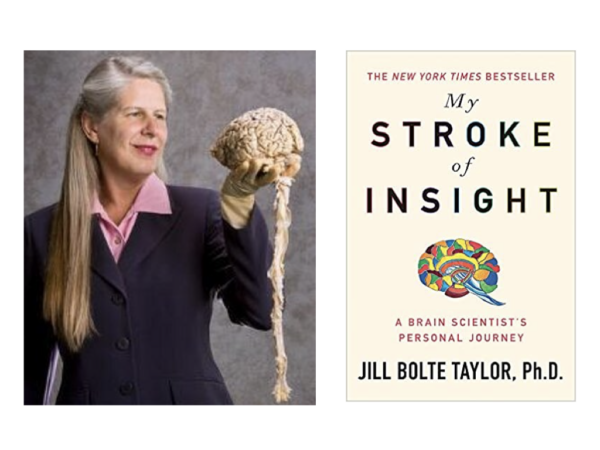
Jill shares with us her recommendations for recovery and the insight she gained into the unique functions of the right and left hemispheres of her brain.
Based upon her academic training and personal experience, Jill helps others not only rebuild their brains from trauma, but helps those of us with normal brains better understand how we can ‘tend the garden of our minds’ to maximize our quality of life.
Jill teaches us through her own example how we might more readily exercise our right hemispheric circuitry with the intention of helping all human beings become more humane.
She has since created a website that provides people with practical tools they can use to help themselves or others when experiencing a stroke. Jill continues to help people to shape a healthy future.
Bill Drayton – The Ashoka Organization’s
Work Supporting Social Entrepreneurs
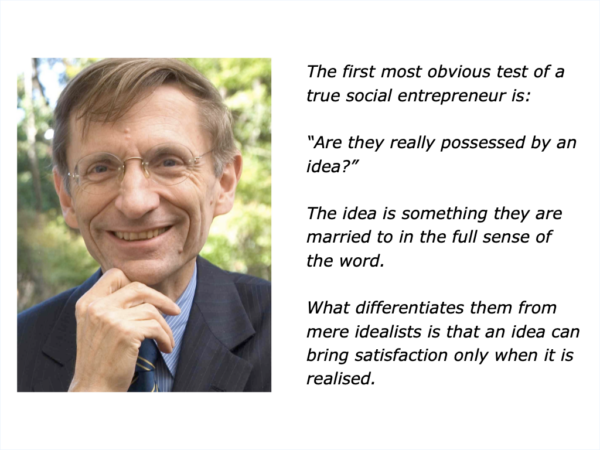
Ashoka is a pioneering organisation that supports social entrepreneurs across the world. These entrepreneurs aim to improve the quality of people’s lives.
They may focus on education, medical care, agriculture, housing, broadcasting or any field of human need. Such people have the passion and practical skills to translate their vision into reality.
Bill Drayton, the organisation’s founder, explained this in the following way.
“What differentiates Ashoka Fellows from mere idealists is that, for these rare men and women, an idea can bring satisfaction only when it is realised.
“Possessing the same unstoppable drive of a Steve Jobs, they define new issues and create new approaches. Their innovations then set new yardsticks of performance for helping society.”
Ashoka’s Fellows have the ability to make ideas stick. Based on research, the organisation’s web site explains the results.
“By the end of their 5-year fellowship, between fifty and sixty per cent of the Fellows have changed national policy in the countries where they have been working, and ninety percent have seen independent institutions copy their innovations.”
Why the name Ashoka?
Bill Drayton started the organisation in 1980. He chose the name in recognition of Ashoka, a great leader who transformed the Indian sub-continent in the 3rd Century BC. (Sometimes his name is also spelt ‘Asoka’.)
Emperor Ashoka initially threw himself into waging war against his neighbours but became horrified by the carnage. Converting to Buddhism, he dedicated himself to improving people’s lives.
Deeply committed to his own beliefs, Ashoka nevertheless spread religious tolerance. Historians are split over the value of his legacy, but all agree that his reign produced great prosperity. H.G. Wells wrote in his book Short History of the World:
Amidst the tens of thousands of names of monarchs that crowd the columns of history the name of Ashoka shines, and shines almost alone, a star.
His reign for eight-and-twenty years was one of the brightest interludes in the troubled history of mankind.
He organised a great digging of wells in India and the planting of trees for shade. He founded hospitals and public gardens and gardens for the growing of medicinal herbs.
He created a ministry for the care of the aborigines and subject races of India. He made provision for the education of women.
“Such was Ashoka, the greatest of kings. He was far in advance of his age.”
Bill Drayton and
Social Entrepreneurship
Bill was born in New York City in 1943. He came from a family of practical idealists who, amongst other causes, fought for the abolition of slavery and for women’s rights. Speaking to Good Magazine, he explained this in the following way.
“Both my parents showed extraordinary (most would say madly unrealistic!) freedom of spirit at 19. Public service and respect for ideas is a recurrent theme in both the American and Australian sides of my family.
“The fact that the Grimke sisters (anti-slavery and women’s equality) and Wendell Phillips (abolitionist) lie on different branches of the America family suggest another element of deep-seated cultural values that drew these people to one another and, without a word being said, was another wonderful gift from my family.”
Looking back at his life, Bill recalls his own first encounters with entrepreneurship. Starting a one-page newspaper when at primary school, he soon built it into a large publication supported by adverts. He explained this in the following way.
“I can’t tell you how excited I was to get this mimeograph machine. It’s amazing how supportive my parents were.
“There were 64 piles of mimeographed paper that had to be collated and stapled, and it never occurred to me this might be inconvenient to my family.”
Moving through schools, he became increasingly conscious of social entrepreneurs. These included people such as:
Susan Anthony – who fought for Women’s Rights.
Mahatma Gandhi – whose spiritual leadership helped to guide India to independence.
Florence Nightingale – whose work in the Crimean War helped to found modern nursing.
Bill went on to study at Harvard, Oxford and Yale Law School. It was during a summer break at Harvard that he became gripped by the power of social change.
Vinoba Bhave, a disciple of Gandhi, was walking across India, persuading individuals and whole villages to legally ‘gift’ their land to him. He then redistributed the land more equitably to support untouchables and other landless people.
Bill was 20 years old at the time and on vacation in Munich. Hearing about Bhave’s work, however, he drove a Volkswagen van from Munich to India to join him.
Returning to the USA, Bill organised Civil Rights sit-ins – an event he later described as one of the more formative experiences of his life.
Pursuing his professional career, he worked at McKinsey, the consulting firm, and as an administrator at the White House during the Carter years. One of his key legacies was the carbon emission trading scheme.
Whilst having a strong academic background himself, Bill believes it is now vital to help young people to develop other skills. These include empathy, problem solving and teamwork. Here he describes some of these qualities.
Building Ashoka
Inspired by social entrepreneurs from the past, Bill decided to found Ashoka. It started with an annual budget of $50,000. This was seeded by the MacArthur Fellowship he was awarded.
The budget has now grown to more than $30 million. The first Fellow was elected in India in 1981. Today it supports over 2000 Fellows in more than 60 countries across the world.
It is funded by individuals, foundations and business entrepreneurs. It does not accept funding from government institutions. Ashoka explains its philosophy as founded on the premise that:
The most effective way to promote positive social change is to invest in social entrepreneurs with innovative solutions that are sustainable and replicable, both nationally and globally.
Bill disagrees strongly with the notion that ‘today there is less leadership in the world.’ He believes people are retaking charge of their lives – particularly in the citizen sector. Why? Older institutions no longer serve the emerging needs.
Learning from business entrepreneurs who have dominated the past 30 years, many caring people are becoming what Bill calls changemakers. Speaking to US News and World Report, he explained this in the following way.
“(The social sector) has been generating jobs at 2.5 to three times as fast as the rest of society. The U.S. more than doubled the number of IRS-recognized charities in a decade.
“Brazil grew from somewhere between 500 and 3,600 citizen groups in 1980 to an estimated more than 1 million by the year 2000. There are similar statistics from every continent.”
Talent is flocking to the sector, says Bill, because people believe it is where they can make a positive difference.
Certainly there is a place for pressuring old institutions to change, but it can be quicker to build successful prototypes. Let’s explore one of the ways that Ashoka helps to make this happen.
Ashoka supports
social entrepreneurs
Social entrepreneurs are the engines of social change and role models for the citizen sector, says Ashoka. It provides such people with a living stipend, often for three years.
This allows them to work full-time on implementing their idea. Additionally it provides them with ‘entrepreneur-to-entrepreneur’ support and access to expert advice.
Ashoka spends a considerable amount of time selecting its Fellows. It looks for five qualities in such people. Let’s explore these themes.
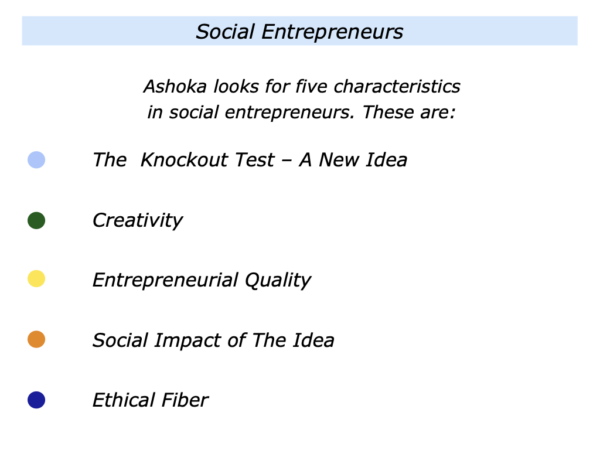
They must have a new idea
– this is The Knockout Test
The person must be possessed by a new idea. It must be a new approach to a social problem that will make a breakthrough in a particular field.
Joaquín Felipe Leguía Orezzoli, for example, is creating ‘Children’s Forests’ in Peru. The grandson of a former President of Peru, he involves children in managing the community forests. The Ashoka site explains his story.
As a child, Joaquín’s garden was a refuge from the world and a space to explore his imagination.
After his mother married a Swedish businessman who worked in the Amazon, Joaquín spent his summer vacations in the jungle, which further inspired his creativity.
There, he also became friends with a young Shipibo indigenous boy who shared adventures with him and inspired his early interest in the role of children in the environment.
After a failed attempt to please his parents by studying business, the political situation in Peru led Joaquín to finish his studies in the United States, where he earned his bachelor’s degree from Cornell University in natural sciences.
After returning to Peru and working in a variety of public, private, and non-profit jobs, Joaquín attended Yale University and earned his master’s degree in environmental management.
He travelled to Bolivia to study the role of indigenous children in community development for his thesis project, an experience that affirmed his conviction to work in youth environmental conservation.
Returning to Peru in 1995 he and a friend founded the Association for Children and the Conservation of Their Environment.
Joaquín’s idea passed The Knockout Test. The organisation he leads aims to increase children’s appreciation of nature and equip them with practical skills to sustain their environment in the future. Many of these areas go on to be actually managed by the young people.
They must have creativity
Creativity is crucial. Ashoka asks some of the following questions regarding candidates.
Does this candidate have a vision to meet some human need better than it has been met before? Do they have a history of creating other new visions?
Creativity obviously comes in different forms. Ashoka is looking for people who can move beyond their original idea and find creative solutions on the road to success.
They must have
entrepreneurial quality
Great entrepreneurs get the right balance between innovation, implementation and impact. They start by having an innovative idea, but this is only the start.
They want to implement the idea and make a positive impact. Ashoka’s entrepreneurs are possessed by their vision and want to translate it into reality. They are dreamers who do and deliver.
They must have an idea
that has social impact
Ashoka focuses on the candidate’s idea – not just the candidate. The idea must be able to live beyond the person’s involvement.
Marie Haisova, for example, has involved women in reducing pollution in major Czech cities. The Ashoka site describes some of her achievements.
Marie’s program encourages mothers to spearhead the development of a beautiful and healthy urban environment of new parks and green spaces.
Her program provides training and leadership-building seminars for women so they can effectively launch their own neighborhood campaigns.
By providing women with the opportunity to change the area in which they live, Marie is both improving the poor condition of city environments and empowering women to become active community leaders.
They must have ethical fiber
Social entrepreneurs must have an internal moral compass. This is called into action on many occasions.
First, when they face setbacks. Can they revisit their inner values and make decisions based on this compass?
Second, when they invite other people to adopt a fresh approach towards tackling a problem. Ashoka says that people will ask: “Do we trust this person absolutely?”
Third, when they experience pressure or personal attacks. The candidate must then be seen to behave ethically in every way.
Ashoka envisions a world where ‘Everyone is a Changemaker’. This is a world that responds quickly and effectively to social challenges. It is one where each individual has the freedom, confidence and societal support to address any social problem and drive change.
This is the organisation’s vision – so what is the reality? Between 50% and 60% of the Fellows change national policy in their respective countries. Ninety percent see independent institutions copy their ideas. This is a remarkable bottom-line in any language.
Bill Drayton is optimistic about the future. Outlining his view of the part Ashoka can play in history, he gave the following view to the US News and World Report.
I have never doubted that we are serving the most powerful and most hopeful historical force of our era. Or that we are positioned to play a truly important role. We are, after all, a community of most of the world’s leading social entrepreneurs.
How could any entrepreneur, confronted by such amazing opportunities to help transform the world and to do so with such extraordinary colleagues, be tempted to lose focus?
In the world ten years from now, it will not be possible to be a citizen without being a change-maker. Anyone who is not will feel themselves to be enormously vulnerable.
More important, they will not be able to participate in the giving and receiving of love and respect, the heart of human existence, at its most important level – causing change for the good.
There are many ways to live life. Some people choose to follow the grateful approach rather than the grumpy approach. They focus on the themes of gratitude, generosity and good work.
Let’s return to your own life and work. Imagine that you want to continue to do good work that helps people or the planet. How can you do this in your own way?
If you wish, try tackling the final exercise on this theme. This invites you to complete the following sentences.
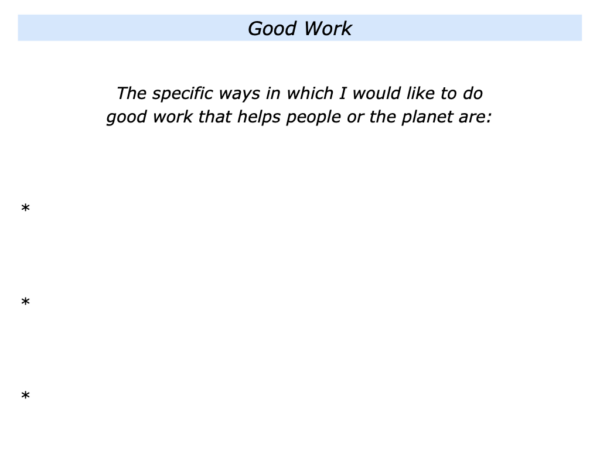






Leave a Reply